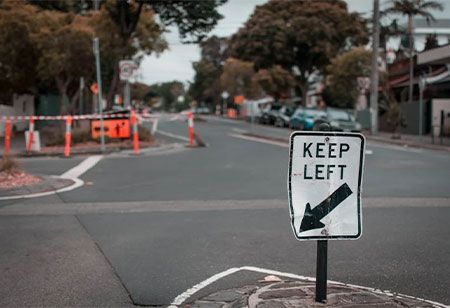
The significance of construction road signs is apparent in the busy tapestry of urban life, where development proceeds steadily. These road protectors also act as vital conduits, arranging for the safe movement of automobiles and people through construction zones.
At the intersection of urban planning and safety, construction road signs inform, direct, and protect, ensuring that the inevitable march of progress does not come at the cost of safety and order.
Below, we will talk about these signs' pivotal role in urban environments, underscoring their significance in maintaining harmony amid the chaos of development and daily life.
Urban areas constantly evolve with construction projects to improve infrastructure, connectivity, and living standards. However, these construction activities often have challenges, particularly regarding safety and urban planning.
A meticulous approach to urban safety and planning during construction is fundamental to minimizing potential risks to pedestrians, cyclists, motorists, and workers. This approach's essential components are effective signage, like the W5 Road Signs, designed to guide, warn, and protect road users from potential hazards in construction zones and throughout the road.
Ensuring the safety of urban environments during construction requires a comprehensive strategy that includes risk assessment, implementing safety measures, and consistent monitoring.
Safety measures aim to prevent accidents and maintain the flow of urban life with minimal disruptions. This includes temporary adjustments in traffic patterns, pedestrian routes, and public transportation schedules.
Through regulatory compliance, technology integration, and community engagement, cities can manage construction projects without compromising their inhabitants' safety and convenience.
Construction road signs are vital for the safety of pedestrians and drivers. They provide crucial information about upcoming construction zones, detours, and road closures. By warning other road users ahead of time, these signs help lower the possibility of accidents brought on by unexpected barriers or abrupt stops.
Properly placed signs contribute significantly to the overall traffic flow around construction sites, maintaining order and efficiency despite disruptions.
Frequent safety measures in construction incorporate warning signs, construction ahead notifications, fluorescent cones, flagging for traffic control, and signal lights. Establishing a protective boundary that separates the road from sidewalks or pathways adjacent to the construction zone is crucial.
Employing barriers or lights to delineate the area effectively prevents the accidental intrusion of pedestrians into the work zone, potentially averting injuries.
Numerous instances, often depicted in humorous yet unfortunate online videos, have involved individuals unintentionally entering construction sites during nighttime, resulting in falls or vehicles like scooters and cars mistakenly navigating into these areas.
Additionally, whether your traffic construction projects occur at night or not, there are numerous justifications for the necessity of lighting and traffic control equipment. Your work area may suffer from inadequate lighting even during daytime hours.
Similarly, allowing traffic to notice the construction site from a considerable distance can lead them to slow down and heighten their awareness. Regardless of the nature of your project - be it asphalt work, highway maintenance, or complete reconstruction - ensuring safety to prevent any vehicle-related accidents on site is paramount.
The role of well-designed and strategically placed road signs cannot be overstated in ensuring smooth navigation and minimizing traffic disruptions in construction zones. Enhancing Navigation and Minimizing Traffic Disruptions Using Road Signs in Construction Areas is not just a matter of convenience but a crucial aspect of road safety and efficiency.
Effective road signage communicates the road's conditions to the motorist, providing necessary guidance and warnings. In areas under construction, where unexpected changes to the road layout can lead to confusion and accidents, these signs are the lifelines that maintain order and safety.
They inform drivers of upcoming diversions, closed lanes, reduced speed zones, and the presence of workers, enabling motorists to adjust their speed and position in advance.
Construction crews and municipal planners can greatly lower the risk of accidents and traffic congestion in construction zones by implementing a proactive strategy for road sign placement.
Workers involved in road and highway construction play a key role in maintaining roadway safety, adding new lanes and exits, and executing other essential transportation initiatives. Nonetheless, their tasks, often performed alongside fast-moving vehicles or at night, lead to regrettable incidents and loss of life.
Like in any unfamiliar setting, individuals involved in road or highway construction projects must undergo adequate training to understand the established policies and potential risks. Ensuring your team receives uniform guidelines guarantees that all members adhere to identical safety procedures.
Additionally, It’s vital that they can recognize warning signs easily. Warning signs are typically yellow and display symbols or text indicating what to expect ahead. These might warn of upcoming construction, lane closures, speed limit changes, or machinery crossing areas. Recognizing and reacting to these signs can significantly reduce the risk of accident or injury.
Moreover, detour signs guide drivers along an alternative route around the construction zone. They are critical for maintaining traffic flow and preventing congestion. Following detour instructions helps you reach your destination efficiently and ensures the safety of workers and other motorists.
Construction road signs are more than just temporary fixtures on city roads. They are an indispensable part of urban planning and safety, ensuring the well-being of all road users amidst the complexities of urban development. Cities may greatly improve the efficiency and safety of their roadways, making urban areas safer and easier for everyone to navigate, by prioritizing the strategic placement and upkeep of these signs.
We use cookies to ensure you get the best experience on our website. Read more...